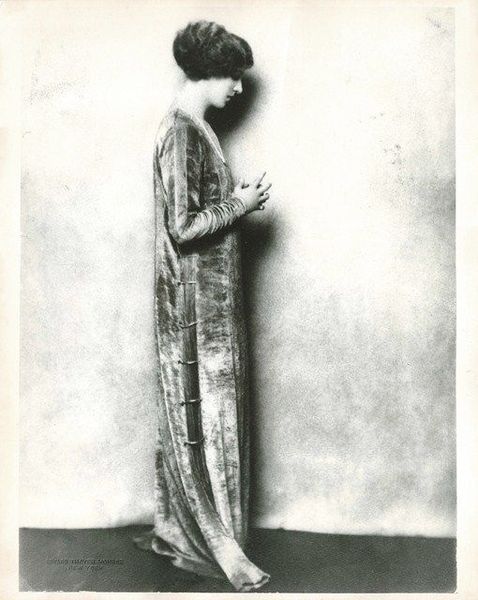"Fortuny y Madrazo: An Artistic Legacy" on view at Queen Sofía Spanish Institute in New York
Mrs. William Wetmore modeling a Delphos gown in front of Fortuny fabric. Originally published in Vogue, December 15, 1935. Photo: Lusha Nelson © Condé Nast Publications.
NEW YORK, NY.- Queen Sofía Spanish Institute is presenting Fortuny y Madrazo: An Artistic Legacy, a seminal exhibition analyzing the work of celebrated Spanish artist and designer Mariano Fortuny y Madrazo (1871–1949) in the context of the family of artists from which he descended. Conceived by and curated with Oscar de la Renta, chairman of the Institute’s board of directors, this is the first exhibition to examine the impact of both the matrilineal and paternal artistic legacies on Fortuny’s groundbreaking work in numerous fields, from textile and clothing design to visual arts, and elaborating on the origins and influences that shaped his extraordinary career.
Fortuny was born into an artistic dynasty in Spain, and the work of his forefathers had a profound impact on him. Fortuny himself declared, “I have always had many interests, but I have always considered painting to be my profession.” On his mother’s side, the Madrazos helped to shape the course of art history from the early nineteenth century onwards through their roles as distinguished artists, curators and collectors, while the critical and commercial successes of Fortuny’s father, Mariano Fortuny y Marsal, made him one of the most important artists in the history of Spanish art after Francisco Goya.
Born in Granada, and raised in Paris, Fortuny spent his adult life in Venice, where his prodigious output was the result of a career that spanned over fifty years. Trained as a painter, Fortuny was well regarded as an artist in a diverse array of genres and media, but it was through his clothing and textile designs that his exceptional artistic sensibilities reached their zenith, as well as a large international audience. These creations were an extension of Fortuny’s deeply personal artistic interests and existed outside of fashion’s seasonal collections and ever-evolving silhouettes, yet they were nonetheless coveted by the fashionable elite. Like his father, who was fascinated by orientalist themes, Fortuny found rich inspiration in many sources, including the art, history, and culture of his native Spain as well as those of ancient Greece, North Africa, Japan, and the Italian Renaissance, relying on a design vocabulary that changed little over time. Many of his clothing designs, including the iconic Delphos dress, emphasized movement and the natural shape of an un-corseted body—just one of the ways that Fortuny’s clothing, although steeped in history, revealed a modern sensibility that helped to push fashion forward at the turn of the twentieth century.
Fortuny y Madrazo: An Artistic Legacy brings together a stunning array of Fortuny’s work, from the luxurious textile and clothing designs for which he is world renowned to paintings, lithographs, and photographs. Artwork by Mariano Fortuny y Marsal, as well as paintings by members of the Madrazo family, demonstrates the strong influence of Fortuny’s predecessors, who imbued him with a unique historical perspective and a deep appreciation for their artistic legacy. Sumptuous fabrics designed by Fortuny, and still produced today, will provide a spectacular backdrop to the show.
Unprecedented loans include objects from Madrid’s Museo del Traje and Comunidad de Madrid, the Museo Fortuny in Venice, The Hispanic Society of America, and The Museum of the City of New York. The exhibition also features significant pieces from leading private collectors Regina Drucker, Keith McCoy, the Riad family, Sandy Schreier, and Mark Walsh.
Countess Elsie Lee Gozzi wearing an Eleanora dress, 1920s. Photograph by Edward Thaver Monroe; Courtesy of the Riad Family.

/https%3A%2F%2Fprofilepics.canalblog.com%2Fprofilepics%2F1%2F0%2F100183.jpg)
/https%3A%2F%2Fstorage.canalblog.com%2F03%2F02%2F119589%2F96711876_o.jpg)
/https%3A%2F%2Fstorage.canalblog.com%2F11%2F31%2F119589%2F94773502_o.jpg)
/https%3A%2F%2Fstorage.canalblog.com%2F20%2F83%2F119589%2F94772815_o.jpg)
/https%3A%2F%2Fstorage.canalblog.com%2F26%2F72%2F119589%2F75604929_o.jpg)
/https%3A%2F%2Fstorage.canalblog.com%2F59%2F60%2F119589%2F26458628_o.jpg)




/http%3A%2F%2Fstorage.canalblog.com%2F35%2F33%2F119589%2F122162097_o.jpg)
/http%3A%2F%2Fstorage.canalblog.com%2F34%2F24%2F119589%2F117579660_o.jpg)
/http%3A%2F%2Fstorage.canalblog.com%2F70%2F44%2F119589%2F111327194_o.jpg)
/http%3A%2F%2Fstorage.canalblog.com%2F69%2F42%2F119589%2F107196689_o.jpg)